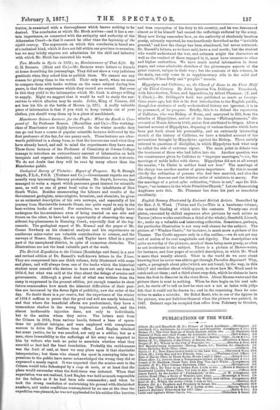English Scenery illustrated by Eminent British Artists. Described by the
Rev. J. G. Wood. (Virtue and Co.)—This is a handsome volume, the tasteful binding of which suits the contents. Twenty-one steel plates, executed by skilful engravers after pictures by such artists as Turner (whose works contribute a third of the whole), Stanfield, Linnell, hoc., make up a valuable and interesting collection. Sometimes, perhaps, the particular illustration is not very well chosen for the subject. The picture of "Windsor Castle," for instance, is much more a picture of the Thames. The Castle appears only in a dim outline,—we do not get any sort of notion of its real magnitude and dignity. The descriptions are quite unworthy of the pictures, much of them being mere gossip, as often as not irrelevant to the subject. There is a picture of Hawes-water, for instance, and four pages of so-called description, in which Mr. Wood is more than usually absurd. What in the world do we care about knowing that he never was able to get through Paradise Regained? Why, again, a paragraph about pike (which are not found, by the way, in this lake)? and another about whiting-pout, to show how Mr. Wood used to catch and eat them ; and a third about cray-fish, which he claims to have been the first to discover in the river Dove. About Hawes-waterand the picture there is next to nothing. When he does begin on his real sub- ject, he starts off to tell us how he once saw a net so laden with jelly. fish that it could not be drawn in; and in the remaining lines he con- trives to make a mistake. Sir Baliol Brett, who is one of the figures in the picture, was not Solicitor-General when the picture was painted, in 1867. Debrett saya he occupied that office from February to October, 1868.






































 Previous page
Previous page